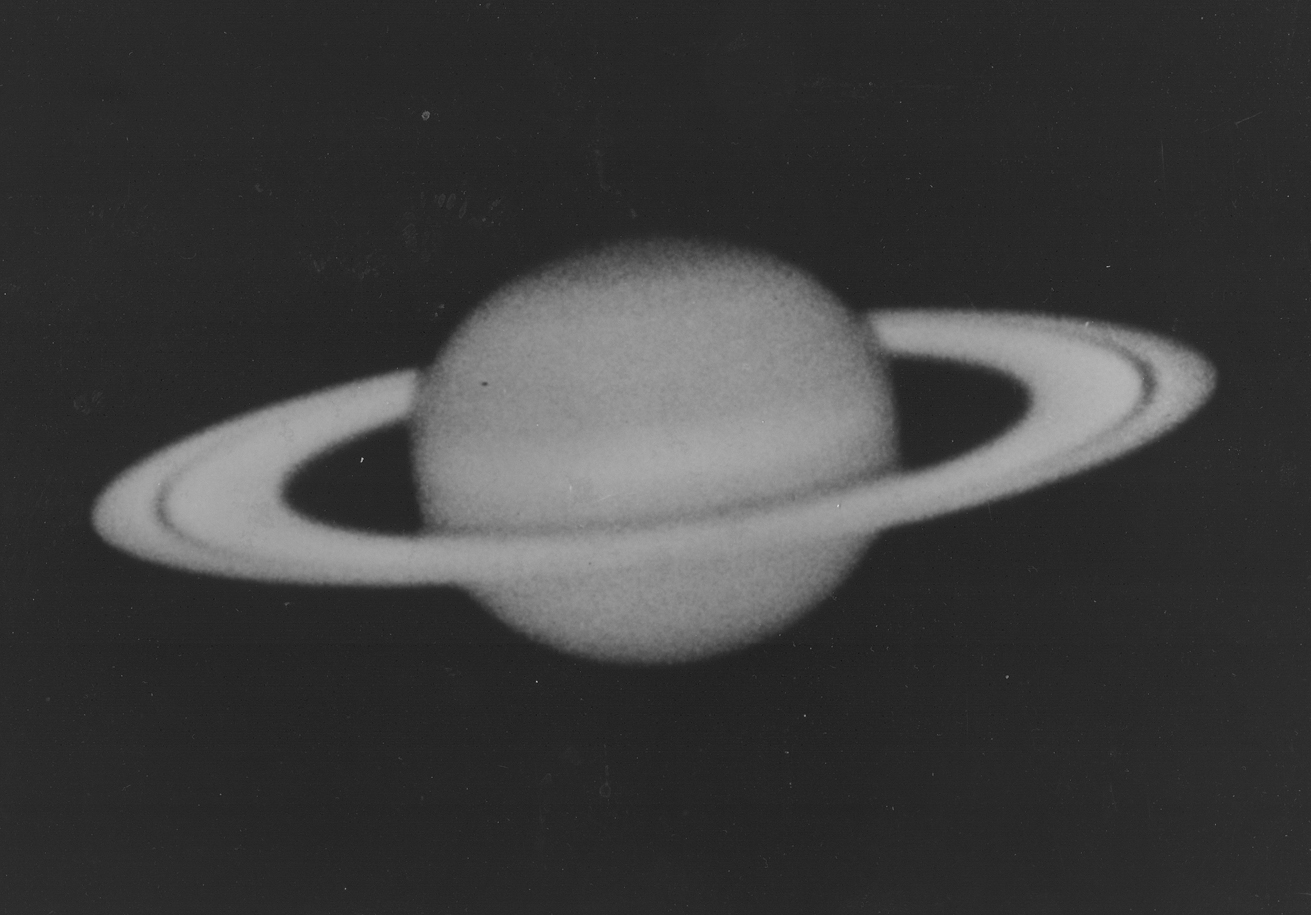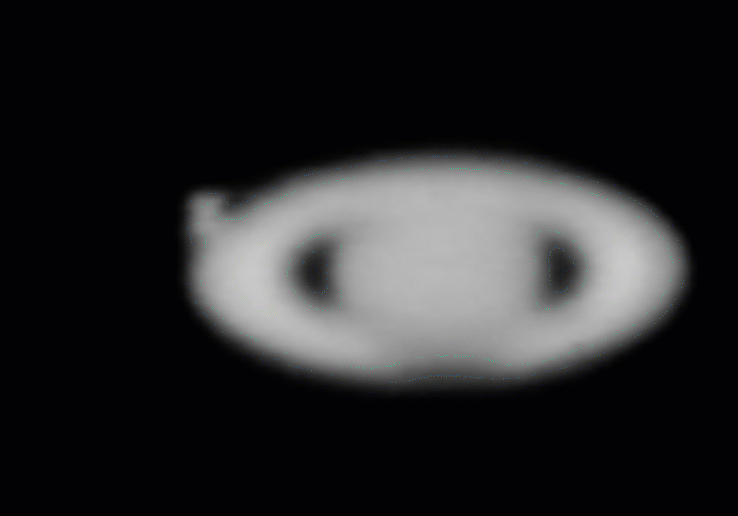Saturn
More Than Just a Pretty Picture...
Ask anyone to tell you their most memorable sight through a telescope and chances are, you can easily predict the answer: “Saturn.”
No matter how many times you’ve seen it, no other planet has the same power to delight. And yet, there never seem to be enough discriminating eyes to explore it for scientific purposes. For all of its allure, for all of the satellite reconnaissance there, Saturn is still an animated world where changes are taking place and for which current observations are being sought. It’s probably not the most important target for inquiry from SRO, but the ringed planet nevertheless illustrates the point that avenues for astronomical research may still be hiding in plain sight even when you think you’ve seen it all.

State of the Art c1963: A Tempting Tease
This photo, taken through the Carroll reflector, represents what could be expected from an observatory-class instrument at the time SRO was completed: a single exposure, sharply defined for that era, captured on high-speed, grainy emulsion media. And yet, a closer look suggests tantalizing details just beyond reach of the technology as it then existed.
The Cassini Division so clearly delineated; the hint of banding in the cloud layers; the dark polar region, now known to be a roughly hexagonal shape, all beg for more attention.
It would be a virtual certainty that a visual observer with decent sketching ability, even using a smaller telescope, could have recorded more detail than is exhibited here. Yet, while drawing remains a viable recording avenue, photographic methods have changed in a big, big way and dominate. Electronics in all their various forms have literally run rings around the once time-honored approach used to make this shot.

State of the Art c1963: A Tempting Tease
This photo, taken through the Carroll reflector, represents what could be expected from an observatory-class instrument at the time SRO was completed: a single exposure, sharply defined for that era, captured on high-speed, grainy emulsion media. And yet, a closer look suggests tantalizing details just beyond reach of the technology as it then existed.
The Cassini Division so clearly delineated; the hint of banding in the cloud layers; the dark polar region, now known to be a roughly hexagonal shape, all beg for more attention.
It would be a virtual certainty that a visual observer with decent sketching ability, even using a smaller telescope, could have recorded more detail than is exhibited here. Yet, while drawing remains a viable recording avenue, photographic methods have changed in a big, big way and dominate. Electronics in all their various forms have literally run rings around the once time-honored approach used to make this shot.

Occultation of 28 Sagittarii (Sge), 3 July 1989
Bill Hornaday
This occultation dispels the notion that "beauty is only skin deep." Details in the structure of Saturn's magnificent, gossamer ring system can be gleaned by carefully measuring the changing brightness of a star as the planet glides past. Similar opportunities for analysis have existed when planetary atmospheres or rings disrupt line-of-sight radio transmissions from spacecraft.
This animation is a time-lapse combination of two sessions, the first (covering 40 minutes, from 5:50-6:30 UT) begins with the "ingress" of the star and the second (roughly 58 minutes long, from ~ 8:29 to 9:27 UT) ending with its emergence.
SRO Member Bill Hornaday, also part of JPL's Infrared Imaging Group, made this capture on VHS tape. It consisted of around 325,000 frames over a span of 3 hours and 37 minutes. While his purpose didn't seem particularly targeted to research, an interesting phenomenon is briefly seen just as the second video segment begins.
The bright flash results from the scintillation effects of Saturn's atmosphere which sharply focused 28 Sge's light as it passed the planet's limb.
The event did prove a couple of "facts," however. First, the solar system isn't static, even if one has to patiently wait for events to occur. A planetary occultation of a bright star is a very rare event and this one was exceedingly so - a "two-fer" - as Saturn's largest moon, Titan, also obscured the star as seen from a narrow groundtrack through Europe.
Secondly, such events are popular. This one drew about a dozen people to SRO who also contributed to the ever-changing nature of the skies above. Their collective body heat, rising through the open air tube of the telescope and funneled out of the dome's slit, helped to degrade the images!

Occultation of 28 Sagittarii (Sge), 3 July 1989
Bill Hornaday
This occultation dispels the notion that "beauty is only skin deep." Details in the structure of Saturn's magnificent, gossamer ring system can be gleaned by carefully measuring the changing brightness of a star as the planet glides past. Similar opportunities for analysis have existed when planetary atmospheres or rings disrupt line-of-sight radio transmissions from spacecraft.
This animation is a time-lapse combination of two sessions, the first (covering 40 minutes, from 5:50-6:30 UT) begins with the "ingress" of the star and the second (roughly 58 minutes long, from ~ 8:29 to 9:27 UT) ending with its emergence.
SRO Member Bill Hornaday, also part of JPL's Infrared Imaging Group, made this capture on VHS tape. It consisted of around 325,000 frames over a span of 3 hours and 37 minutes. While his purpose didn't seem particularly targeted to research, an interesting phenomenon is briefly seen just as the second video segment begins.
The bright flash results from the scintillation effects of Saturn's atmosphere which sharply focused 28 Sge's light as it passed the planet's limb.
The event did prove a couple of "facts," however. First, the solar system isn't static, even if one has to patiently wait for events to occur. A planetary occultation of a bright star is a very rare event and this one was exceedingly so - a "two-fer" - as Saturn's largest moon, Titan, also obscured the star as seen from a narrow groundtrack through Europe.
Secondly, such events are popular. This one drew about a dozen people to SRO who also contributed to the ever-changing nature of the skies above. Their collective body heat, rising through the open air tube of the telescope and funneled out of the dome's slit, helped to degrade the images!







